The First Non-Stop US Transcontinental Flight
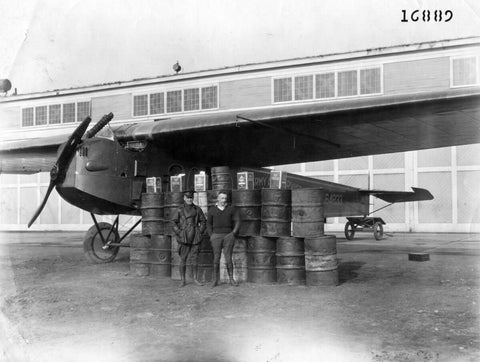
Lts. Macready and Oakley in front of their Fokker T-2 airplane preparing for the first non-stop transcontinental flight across the U.S.
The First Trans-Continental US Flight
It boggles the mind when you consider the first successful manned flight took place over the sands of Kitty Hawk on January 17, 1903, and just 8 years later Calbraith "Cal" Perry Rodgers took off from Sheepshead Bay, NY on September 17, 1922, on a flight to Long Beach, CA.
The first trans-continental flight across America was made in 1911, just 8 years after the Wright’s historic 59-second, 852-foot distance flown over the sands at Kitty Hawk on January 17, 1903.
Rodgers flew the route in a Wright EX biplane which was named "Win Fiz". The name was because Win Fiz was a grape soda drink and the sponsor of the flight.
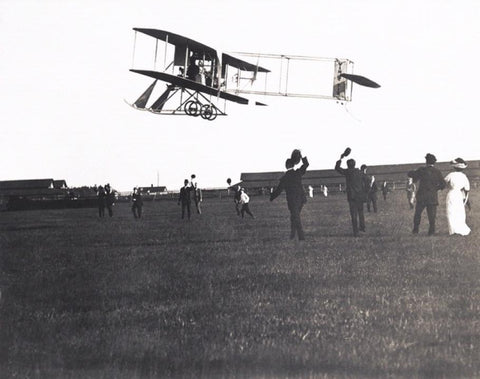
The Wright EX biplane "Win Fiz" in flight.
The Wright EX biplane was powered by a 35-horsepower Wright 4-cylinder water-cooled engine that drove the two pusher propellers.
The impetus for the flight was because the Hearst newspapers offered a $ 50,000 prize for the first transcontinental flight which made the trip within 30 days.
Unfortunately for Rodgers, he had only reached Kansas City by the time 30 days had expired. However, undaunted, Rodgers continued his flight and landed in Long Beach after 49 days, 82 hours and 4 minutes of flight time, and an average speed of 51.5 mph.

The Wright EX biplane "Wiz Fiz" in the National Air and Space Museum.
Early aviators, starting with the Wright Brothers, wore goggles to protect their eyes, mainly from the oil that flew off the engines and into the pilot's face and eyes. At that point in time no one had learned about the harmful effect of Ultraviolet Radiation (UV Light) on our eyes. It surprises me that no one considered sunglasses something worthwhile as they flew long distances advancing aviation.
Instead, they resorted to using goggles similar to the ones worn by drivers and passengers as they drove around in the first automobiles and motorcycles.
After all, the first sunglasses were made by Inuits in the 12th century using walrus tusks flattened with slits and attached to the head with a piece of twine. Surely someone should have thought about that in the early 1900s.
The Fokker F.IV Airplane
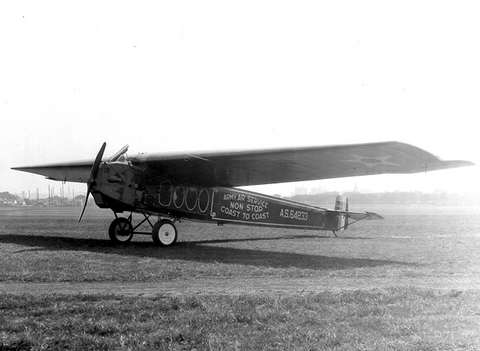
The U.S. Army Air Service T-2 Fokker airplane was built in Veere, Netherlands, and shipped to the U.S. in crates.
The serial numbers of the two T-2 aircraft were A.S. 64233 and A.S. 64234.
It was a high-wing cantilever monoplane with a fixed tail skid. The pilot would sit in an open cockpit that was offset to the left of the aircraft's centerline beside the engine, and the cabin could hold 12 passengers. Before the first one was ever built the U.S. Army Air Force purchased two of them - the only two ever made.
The aircraft was test flown by Anthony Fokker himself, and then both were crated up and shipped to the United States where they were assembled at McCook Field, Ohio.
Specifications of the T-2:
- Crew: One pilot
- Capacity: 12 passengers and one pilot
- Length: 49 feet 3 inches
- Wingspan: 81 feet 4 inches
- Height: 11 feet
- Empty weight: 4,960 pounds
- Gross weight: 7,630 pounds
- Powerplant: One Packard-built Liberty L12 400 hp piston engine
Performance of the T-2:
- Maximum speed: 93 mph, 81 knots
- Range: 2,550 miles
- Service ceiling: 10,500 feet.
The Liberty L-12 V-12 single overhead cam engine had a compression ratio of 5.4:1. It produced 408 hp at 1,800 rpms.
The L-12 was a right-hand tractor direct drive engine, and when installed on A.S. 64233 it turned a two-blade Curtiss fixed-pitch 10 foot 5 inch propeller.
The Liberty 12 engine was 5 feet 7.375 inches long, 2 feet 3 inches wide, and 3 feet 5.5 inches high weighing 844 pounds.
The Pilots and the T-2
In preparation for the non-stop transcontinental flight a number of modifications to the T-2 were made, including an extra set of flight controls inside the cabin so that the aircraft could be controlled while the two pilots changed seats.
Additional fuel tanks were then installed in the wing and cabin areas increasing the fuel capacity of the aircraft in three fuel tanks to 735 gallons.
This meant that the aircraft was over the maximum gross weight specified by the manufacturer; however, at 10,850 pounds the aircraft was just a few pounds less than it's design maximum weight.
The two pilots chosen for this record attempt were 1st Lt. Oakley G. Kelly and Capt. John A. Macready.
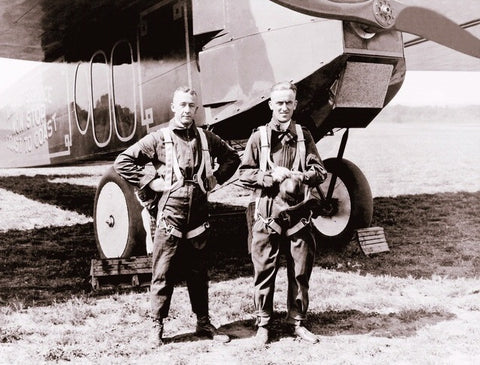
Lts. Macready and Kelly standing in front of U.S. Army Air Service T-1 serial number A.S. 64233.
The first task was to run tests to see if the proposed flight was feasible. During test flights Lts. Kelly and Macready set six Fédération Aéronautique Internationale (FAI) world records for speed, distance, and duration.
They flew the aircraft out of the Wilbur Wright Field in Dayton, OH, preparing for the non-stop transcontinental attempt.
Before attempting the East-to-West non-stop transcontinental attempt, Lts. Macready and Kelly made two unsuccessful attempts to fly the T-2 from west to east.
It is important to note some details about the pilots themselves.
Lt. John A. Macready was one of the most interesting pilots in the U.S. Army Air Service in the 1920's. In 1921 he was awarded the Mackay Trophy for his high-altitude flights, and again in 1922, along with Lt. Kelly, an endurance record of 35 hours in the T-2.
Lt. Macready was also the first pilot to parachute out of an aircraft in an emergency at night, he was the second pilot to fly a pressurized aircraft, the first pilot to crop-dust with an airplane, and the first to fly a photographic aerial expedition in the USA.
The Flight
At 12;30 p.m. EST on May 2, 1923, US Army pilots Macready and Kelly departed Roosevelt-Hazelhurst Field on Long Island in New York, landing at Rockwell Field in San Diego, CA, on May 3rd, 1923, at 12:26 p.m. Pacific Time.
The flight had taken 26 hours, 50 minutes, and 38.8 seconds, with an average speed of 91.996 mph, covering a total of 2,470 miles.
Video showing the T-2 take off on the first successful non-stop transcontinental flight.
Once again Macrady was awarded the Mackay Trophy for the flight, becoming the only pilot in history to win the Trophy three times.
I hope you enjoyed this trip through some of the history of aviation. If you enjoyed this trip, and are new to this newsletter, sign up to receive your own weekly newsletter here: Subscribe here:
Until next time, keep your eyes safe and focused on what's ahead of you, Hersch!





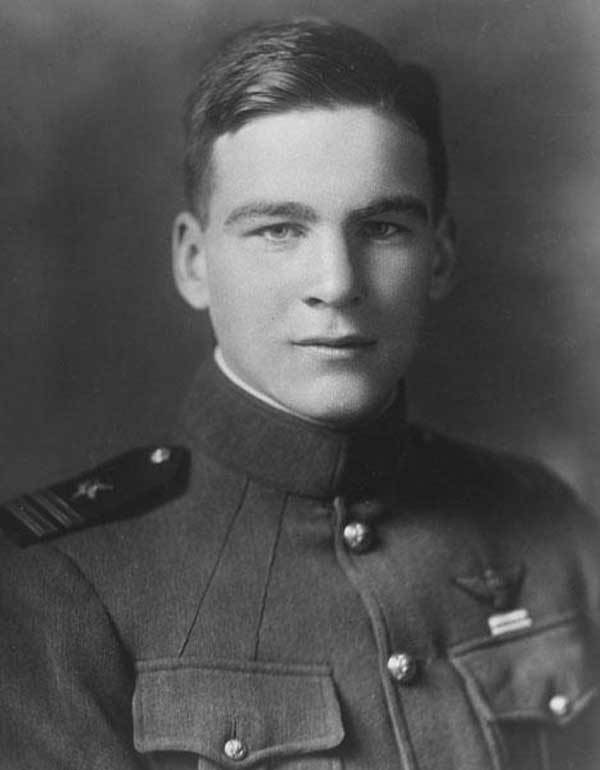
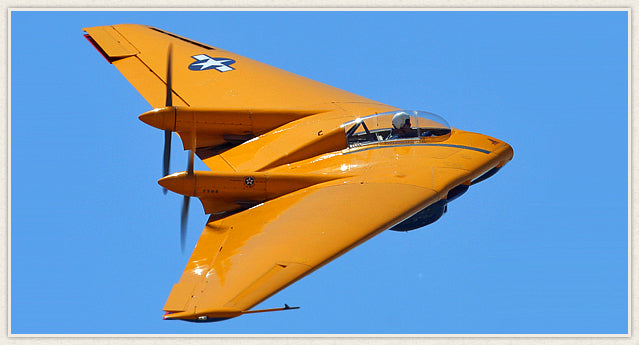
Leave a comment
This site is protected by hCaptcha and the hCaptcha Privacy Policy and Terms of Service apply.